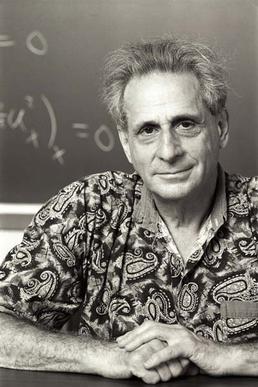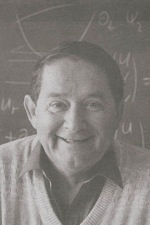Related Research Articles

In mathematics and physics, a soliton is a nonlinear, self-reinforcing, localized wave packet that is strongly stable, in that it preserves its shape while propagating freely, at constant velocity, and recovers it even after collisions with other such localized wave packets. Its remarkable stability can be traced to a balanced cancellation of nonlinear and dispersive effects in the medium. Solitons were subsequently found to provide stable solutions of a wide class of weakly nonlinear dispersive partial differential equations describing physical systems.
In mathematics and physics, the inverse scattering problem is the problem of determining characteristics of an object, based on data of how it scatters incoming radiation or particles. It is the inverse problem to the direct scattering problem, which is to determine how radiation or particles are scattered based on the properties of the scatterer.

Martin David Kruskal was an American mathematician and physicist. He made fundamental contributions in many areas of mathematics and science, ranging from plasma physics to general relativity and from nonlinear analysis to asymptotic analysis. His most celebrated contribution was in the theory of solitons.

In theoretical physics, the (one-dimensional) nonlinear Schrödinger equation (NLSE) is a nonlinear variation of the Schrödinger equation. It is a classical field equation whose principal applications are to the propagation of light in nonlinear optical fibers and planar waveguides and to Bose–Einstein condensates confined to highly anisotropic, cigar-shaped traps, in the mean-field regime. Additionally, the equation appears in the studies of small-amplitude gravity waves on the surface of deep inviscid (zero-viscosity) water; the Langmuir waves in hot plasmas; the propagation of plane-diffracted wave beams in the focusing regions of the ionosphere; the propagation of Davydov's alpha-helix solitons, which are responsible for energy transport along molecular chains; and many others. More generally, the NLSE appears as one of universal equations that describe the evolution of slowly varying packets of quasi-monochromatic waves in weakly nonlinear media that have dispersion. Unlike the linear Schrödinger equation, the NLSE never describes the time evolution of a quantum state. The 1D NLSE is an example of an integrable model.

In physics, a breather is a nonlinear wave in which energy concentrates in a localized and oscillatory fashion. This contradicts with the expectations derived from the corresponding linear system for infinitesimal amplitudes, which tends towards an even distribution of initially localized energy.
In mathematics, and in particular in the theory of solitons, the Dym equation (HD) is the third-order partial differential equation
In mathematics, integrability is a property of certain dynamical systems. While there are several distinct formal definitions, informally speaking, an integrable system is a dynamical system with sufficiently many conserved quantities, or first integrals, that its motion is confined to a submanifold of much smaller dimensionality than that of its phase space.
Victor Isakov was a mathematician working in the field of inverse problems for partial differential equations and related topics. He was a distinguished professor in the Department of Mathematics and Statistics at Wichita State University.
Athanassios Spyridon Fokas is a United States-based Greek academic, educator and scientist, with degrees in Aeronautical Engineering and Medicine. Since 2002, he is Professor of Nonlinear Mathematical Science in the Department of Applied Mathematics and Theoretical Physics (DAMTP) at the University of Cambridge.

In mathematics, the inverse scattering transform is a method that solves the initial value problem for a nonlinear partial differential equation using mathematical methods related to wave scattering. The direct scattering transform describes how a function scatters waves or generates bound-states. The inverse scattering transform uses wave scattering data to construct the function responsible for wave scattering. The direct and inverse scattering transforms are analogous to the direct and inverse Fourier transforms which are used to solve linear partial differential equations.
In mathematics, Riemann–Hilbert problems, named after Bernhard Riemann and David Hilbert, are a class of problems that arise in the study of differential equations in the complex plane. Several existence theorems for Riemann–Hilbert problems have been produced by Mark Krein, Israel Gohberg and others.

Robin K. Bullough was a British mathematical physicist known for his contributions to the theory of solitons, in particular for his role in the development of the theory of the optical soliton, now commonly used, for example, in the theory of trans-oceanic optical fibre communication theory, but first recognised in Bullough's work on ultra-short optical pulses. He is also known for deriving exact solutions to the nonlinear equations describing these solitons and for associated work on integrable systems, infinite-dimensional Hamiltonian systems, and the statistical mechanics for these systems. Bullough also contributed to nonlinear mathematical physics, including Bose–Einstein condensation in magnetic traps.
Robert M. Miura was a Distinguished Professor of Mathematical Sciences and of Biomedical Engineering at New Jersey Institute of Technology (NJIT) in Newark, New Jersey. He was formerly a professor in the Department of Mathematics at the University of British Columbia in Vancouver.
Clifford Spear Gardner was an American mathematician specializing in applied mathematics.
Alan C. Newell is an Irish/American mathematician and Regents Professor at the University of Arizona. He was awarded a Guggenheim Fellowship in 1976 and in 2004 the John von Neumann Lecture for the Society for Industrial and Applied Mathematics. He was a Senior Scientist Humboldt Fellow in 1988–1989 and was elected a Fellow of the Society for Industrial and Applied Mathematics in 2009.
In mathematical physics, the Eckhaus equation – or the Kundu–Eckhaus equation – is a nonlinear partial differential equation within the nonlinear Schrödinger class:

Wiktor Eckhaus was a Polish–Dutch mathematician, known for his work on the field of differential equations. He was Professor Emeritus of Applied Mathematics at the Utrecht University.

Fioralba Cakoni is an American-Albanian mathematician and an expert on inverse scattering theory. She is a professor of mathematics at Rutgers University.
Walter Alexander Strauss is an American applied mathematician, specializing in partial differential equations and nonlinear waves. His research interests include partial differential equations, mathematical physics, stability theory, solitary waves, kinetic theory of plasmas, scattering theory, water waves, and dispersive waves.
Integrable algorithms are numerical algorithms that rely on basic ideas from the mathematical theory of integrable systems.
References
- 1 2 3 Mark J. Ablowitz at the Mathematics Genealogy Project
- 1 2 Company, R. R. Bowker (9 September 1992). American men & women of science: a biographical directory of today's leaders in physical, biological and related sciences. Bowker. ISBN 9780835230759 – via Google Books.
- ↑ Ablowitz, M. J.; Benney, D. J. (1970). "The Evolution of Multi-Phase Modes for Nonlinear Dispersive Waves". Studies in Applied Mathematics. 49 (3): 225–238. doi:10.1002/sapm1970493225. ISSN 0022-2526.
- ↑ "Background - Mark J. Ablowitz". sites.google.com.
- ↑ List of Fellows of the American Mathematical Society, retrieved 2012-11-03.